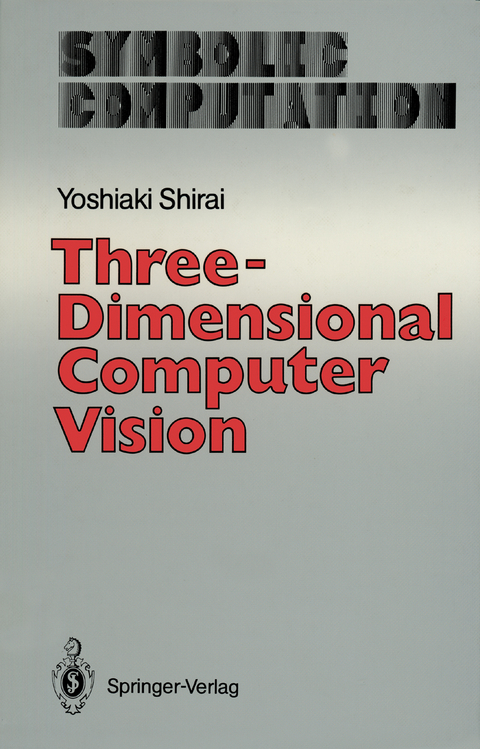
Three-Dimensional Computer Vision
Springer Berlin (Verlag)
978-3-642-82431-9 (ISBN)
1 Introduction.- 1.1 Three-Dimensional Computer Vision.- 1.2 Related Fields.- 1.3 Mainstream of 3D Computer Vision Research.- 2 Image Input.- 2.1 Imaging Geometry.- 2.2 Image Input Devices.- 2.3 Color.- 2.4 Color Input.- 2.5 Range.- 2.6 Moiré Topography.- 2.7 Preprocessing.- 3 Image Feature Extraction.- 3.1 Edge Point Detection.- 3.2 Local Edge Linking.- 3.3 Edge Point Clustering in Parameter Space.- 3.4 Edge-Following Methods.- 3.5 Region Methods.- 4 Image Feature Description.- 4.1 Representation of Lines.- 4.2 Segmentation of a Sequence of Points.- 4.3 Fitting Line Equations.- 4.4 Conversion Between Lines and Regions.- 5 Interpretation of Line Drawings.- 5.1 Roberts' Matching Method.- 5.2 Decomposition of Line Drawings Into Objects.- 5.3 Labeling Line Drawings.- 5.4 Further Problems in Line Drawing Interpretation.- 6 Realizability of Line Drawings.- 6.1 Line Drawings Without Interpretations.- 6.2 Use of Gradient Space.- 6.3 Use of Linear Equation Systems.- 7 Stereo Vision.- 7.1 Stereo Image Geometry.- 7.2 Area-Based Stereo.- 7.3 Feature-Based Stereo.- 8 Shape from Monocular Images.- 8.1 Shape from Shading.- 8.2 Use of Polarized Light.- 8.3 Shape from Geometrical Constraint on Scene.- 9 Range Data Processing.- 9.1 Range Data.- 9.2 Edge Point Detection Along a Stripe Image.- 9.3 Two-Dimensional Edge Operators for Range Images.- 9.4 Scene Segmentation Based on Stripe Image Analysis.- 9.5 Linking Three-Dimensional Edges.- 9.6 Three-Dimensional Region Growing.- 10 Three-Dimensional Description and Representation.- 10.1 Three-Dimensional Curves.- 10.2 Surfaces.- 10.3 Interpolation of Serial Sections with Surface Patches.- 10.4 Generalized Cylinders.- 10.5 Geometric Models.- 10.6 Extended Gaussian Image.- 11 Knowledge Representation and Use.- 11.1 Types of Knowledge.-11.2 Knowledge Representation.- 12 Image Analysis Using Knowledge About Scenes.- 12.1 Analysis of Intensity Images Using Knowledge About Polyhedral Objects.- 12.2 Analysis of Range Images with the Aid of a Junction Dictionary.- 13 Image Understanding Using Two-Dimensional Models.- 13.1 Recognition of Isolated Curved Objects Using a Graph Model.- 13.2 Interpretation of Imperfect Regions Using a Scene Model.- 13.3 Recognition of Multiple Objects Using 2D Object Models.- 14 Image Understanding Using Three-Dimensional Models.- 14.1 Matching for Verification Vision.- 14.2 Object Recognition by Predicting Image Features from Models.- 14.3 Matching Geometric Models to the Description of a Single Object.- 14.4 Recognition of Multiple Objects After Segmentation.- 14.5 Recognition Without Segmentation.- References.
| Erscheint lt. Verlag | 11.1.2012 |
|---|---|
| Reihe/Serie | Computer Graphics - Systems and Applications | Symbolic Computation |
| Zusatzinfo | XII, 298 p. |
| Verlagsort | Berlin |
| Sprache | englisch |
| Maße | 170 x 244 mm |
| Gewicht | 540 g |
| Themenwelt | Mathematik / Informatik ► Informatik ► Software Entwicklung |
| Informatik ► Theorie / Studium ► Künstliche Intelligenz / Robotik | |
| Informatik ► Weitere Themen ► CAD-Programme | |
| Schlagworte | 3D • Artificial Intelligence • CAD • CAM • Computer-Aided Design (CAD) • Computer-Aided Manufacturing (CAM) • Computergraphik • computer vision • Information Processing • Intelligence • Knowledge • Knowledge Representation |
| ISBN-10 | 3-642-82431-5 / 3642824315 |
| ISBN-13 | 978-3-642-82431-9 / 9783642824319 |
| Zustand | Neuware |
| Haben Sie eine Frage zum Produkt? |
aus dem Bereich


